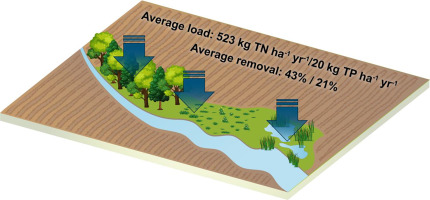当前位置:
X-MOL 学术
›
Sci. Total Environ.
›
论文详情
Our official English website, www.x-mol.net, welcomes your
feedback! (Note: you will need to create a separate account there.)
Wetland buffer zones for nitrogen and phosphorus retention: Impacts of soil type, hydrology and vegetation.
Science of the Total Environment ( IF 8.2 ) Pub Date : 2020-04-16 , DOI: 10.1016/j.scitotenv.2020.138709 Craig R Walton 1 , Dominik Zak 2 , Joachim Audet 3 , Rasmus Jes Petersen 3 , Jelena Lange 4 , Claudia Oehmke 4 , Wendelin Wichtmann 4 , Jürgen Kreyling 4 , Mateusz Grygoruk 5 , Ewa Jabłońska 6 , Wiktor Kotowski 6 , Marta M Wiśniewska 6 , Rafael Ziegler 7 , Carl C Hoffmann 3
Science of the Total Environment ( IF 8.2 ) Pub Date : 2020-04-16 , DOI: 10.1016/j.scitotenv.2020.138709 Craig R Walton 1 , Dominik Zak 2 , Joachim Audet 3 , Rasmus Jes Petersen 3 , Jelena Lange 4 , Claudia Oehmke 4 , Wendelin Wichtmann 4 , Jürgen Kreyling 4 , Mateusz Grygoruk 5 , Ewa Jabłońska 6 , Wiktor Kotowski 6 , Marta M Wiśniewska 6 , Rafael Ziegler 7 , Carl C Hoffmann 3
Affiliation

|
Wetland buffer zones (WBZs) are riparian areas that form a transition between terrestrial and aquatic environments and are well-known to remove agricultural water pollutants such as nitrogen (N) and phosphorus (P). This review attempts to merge and compare data on the nutrient load, nutrient loss and nutrient removal and/or retention from multiple studies of various WBZs termed as riparian mineral soil wetlands, groundwater-charged peatlands (i.e. fens) and floodplains. Two different soil types ('organic' and 'mineral'), four different main water sources ('groundwater', 'precipitation', 'surface runoff/drain discharge', and 'river inundation') and three different vegetation classes ('arboraceous', 'herbaceous' and 'aerenchymous') were considered separately for data analysis. The studied WBZs are situated within the temperate and continental climatic regions that are commonly found in northern-central Europe, northern USA and Canada. Surprisingly, only weak differences for the nutrient removal/retention capability were found if the three WBZ types were directly compared. The results of our study reveal that for example the nitrate retention efficiency of organic soils (53 ± 28%; mean ± sd) is only slightly higher than that of mineral soils (50 ± 32%). Variance in load had a stronger influence than soil type on the N retention in WBZs. However, organic soils in fens tend to be sources of dissolved organic N and soluble reactive P, particularly when the fens have become degraded due to drainage and past agricultural usage. The detailed consideration of water sources indicated that average nitrate removal efficiencies were highest for ground water (76 ± 25%) and lowest for river water (35 ± 24%). No significant pattern for P retention emerged; however, the highest absolute removal appeared if the P source was river water. The harvesting of vegetation will minimise potential P loss from rewetted WBZs and plant biomass yield may promote circular economy value chains and provide compensation to land owners for restored land now unsuitable for conventional farming.
中文翻译:

氮磷滞留的湿地缓冲区:土壤类型、水文和植被的影响。
湿地缓冲区 (WBZ) 是在陆地和水生环境之间形成过渡的河岸区域,以去除氮 (N) 和磷 (P) 等农业水污染物而闻名。这篇综述试图合并和比较来自被称为河岸矿质土壤湿地、地下水泥炭地(即沼泽)和洪泛平原的各种 WBZ 的多项研究中关于养分负荷、养分流失和养分去除和/或保留的数据。两种不同的土壤类型(“有机”和“矿物”),四种不同的主要水源(“地下水”、“降水”、“地表径流/排水量”和“河流淹没”)和三种不同的植被类别(“乔木','草本'和'通气组织')分别考虑用于数据分析。研究的 WBZ 位于中欧北部、美国北部和加拿大常见的温带和大陆性气候区域内。令人惊讶的是,如果直接比较三种 WBZ 类型,则仅发现养分去除/保留能力的微弱差异。我们的研究结果表明,例如有机土壤的硝酸盐保留效率(53 ± 28%;平均值 ± sd)仅略高于矿质土壤(50 ± 32%)。负荷变化对 WBZ 中 N 保留的影响大于土壤类型。然而,沼泽中的有机土壤往往是溶解有机氮和可溶性活性磷的来源,特别是当沼泽由于排水和过去的农业使用而退化时。对水源的详细考虑表明,地下水的平均硝酸盐去除效率最高(76±25%),河水最低(35±24%)。没有出现显着的 P 保留模式;然而,如果 P 源是河水,则出现最高的绝对去除量。植被的收获将最大限度地减少再润湿的 WBZ 的潜在磷损失,植物生物质产量可能会促进循环经济价值链,并为现在不适合传统耕作的恢复土地向土地所有者提供补偿。
更新日期:2020-04-16
中文翻译:

氮磷滞留的湿地缓冲区:土壤类型、水文和植被的影响。
湿地缓冲区 (WBZ) 是在陆地和水生环境之间形成过渡的河岸区域,以去除氮 (N) 和磷 (P) 等农业水污染物而闻名。这篇综述试图合并和比较来自被称为河岸矿质土壤湿地、地下水泥炭地(即沼泽)和洪泛平原的各种 WBZ 的多项研究中关于养分负荷、养分流失和养分去除和/或保留的数据。两种不同的土壤类型(“有机”和“矿物”),四种不同的主要水源(“地下水”、“降水”、“地表径流/排水量”和“河流淹没”)和三种不同的植被类别(“乔木','草本'和'通气组织')分别考虑用于数据分析。研究的 WBZ 位于中欧北部、美国北部和加拿大常见的温带和大陆性气候区域内。令人惊讶的是,如果直接比较三种 WBZ 类型,则仅发现养分去除/保留能力的微弱差异。我们的研究结果表明,例如有机土壤的硝酸盐保留效率(53 ± 28%;平均值 ± sd)仅略高于矿质土壤(50 ± 32%)。负荷变化对 WBZ 中 N 保留的影响大于土壤类型。然而,沼泽中的有机土壤往往是溶解有机氮和可溶性活性磷的来源,特别是当沼泽由于排水和过去的农业使用而退化时。对水源的详细考虑表明,地下水的平均硝酸盐去除效率最高(76±25%),河水最低(35±24%)。没有出现显着的 P 保留模式;然而,如果 P 源是河水,则出现最高的绝对去除量。植被的收获将最大限度地减少再润湿的 WBZ 的潜在磷损失,植物生物质产量可能会促进循环经济价值链,并为现在不适合传统耕作的恢复土地向土地所有者提供补偿。































 京公网安备 11010802027423号
京公网安备 11010802027423号